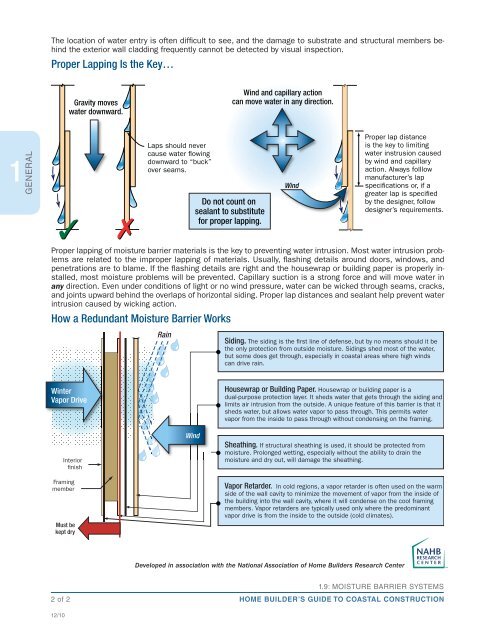FEMA P-499: Home Builder's Guide to Coastal Construction
FEMA P-499: Home Builder's Guide to Coastal Construction
FEMA P-499: Home Builder's Guide to Coastal Construction
Create successful ePaper yourself
Turn your PDF publications into a flip-book with our unique Google optimized e-Paper software.
1<br />
GENERAL<br />
The location of water entry is often difficult <strong>to</strong> see, and the damage <strong>to</strong> substrate and structural members behind<br />
the exterior wall cladding frequently cannot be detected by visual inspection.<br />
Proper Lapping Is the Key…<br />
2 of 2<br />
12/10<br />
Gravity moves<br />
water downward.<br />
Proper lapping of moisture barrier materials is the key <strong>to</strong> preventing water intrusion. Most water intrusion problems<br />
are related <strong>to</strong> the improper lapping of materials. Usually, flashing details around doors, windows, and<br />
penetrations are <strong>to</strong> blame. If the flashing details are right and the housewrap or building paper is properly installed,<br />
most moisture problems will be prevented. Capillary suction is a strong force and will move water in<br />
any direction. Even under conditions of light or no wind pressure, water can be wicked through seams, cracks,<br />
and joints upward behind the overlaps of horizontal siding. Proper lap distances and sealant help prevent water<br />
intrusion caused by wicking action.<br />
How a Redundant Moisture Barrier Works<br />
Winter<br />
Vapor Drive<br />
Interior<br />
nish<br />
Framing<br />
member<br />
Must be<br />
kept dry<br />
Laps should never<br />
cause water owing<br />
downward <strong>to</strong> “buck”<br />
over seams.<br />
Rain<br />
Wind<br />
Do not count on<br />
sealant <strong>to</strong> substitute<br />
for proper lapping.<br />
Wind and capillary action<br />
can move water in any direction.<br />
Wind<br />
Proper lap distance<br />
is the key <strong>to</strong> limiting<br />
water instrusion caused<br />
by wind and capillary<br />
action. Always folllow<br />
manufacturer’s lap<br />
specications or, if a<br />
greater lap is specied<br />
by the designer, follow<br />
designer’s requirements.<br />
Siding. The siding is the rst line of defense, but by no means should it be<br />
the only protection from outside moisture. Sidings shed most of the water,<br />
but some does get through, especially in coastal areas where high winds<br />
can drive rain.<br />
Housewrap or Building Paper. Housewrap or building paper is a<br />
dual-purpose protection layer. It sheds water that gets through the siding and<br />
limits air intrusion from the outside. A unique feature of this barrier is that it<br />
sheds water, but allows water vapor <strong>to</strong> pass through. This permits water<br />
vapor from the inside <strong>to</strong> pass through without condensing on the framing.<br />
Sheathing. If structural sheathing is used, it should be protected from<br />
moisture. Prolonged wetting, especially without the ability <strong>to</strong> drain the<br />
moisture and dry out, will damage the sheathing.<br />
Vapor Retarder. In cold regions, a vapor retarder is often used on the warm<br />
side of the wall cavity <strong>to</strong> minimize the movement of vapor from the inside of<br />
the building in<strong>to</strong> the wall cavity, where it will condense on the cool framing<br />
members. Vapor retarders are typically used only where the predominant<br />
vapor drive is from the inside <strong>to</strong> the outside (cold climates).<br />
Developed in association with the National Association of <strong>Home</strong> Builders Research Center<br />
1.9: MOISTURE BARRIER SYSTEMS<br />
HOME BUILDER’S GUIDE TO COASTAL CONSTRUCTION


